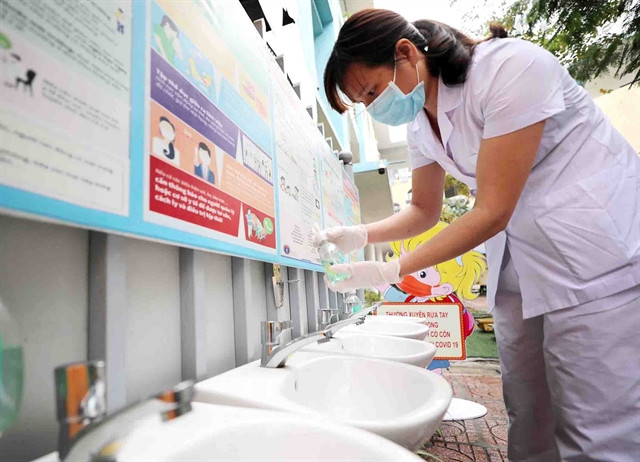 |
| A medical worker checks washbasins at a kindergarten. — VNA/VNS Thanh Tùng |
As schools in HCM City struggle to provide adequate health care to students due to a lack of staff, the city is taking steps to establish a more robust school health system.
Despite the importance of school health care, many schools have been unable to meet the growing demand for these services. To address this issue, the city is working to strengthen its school health system to meet the needs of students and families better.
HCM City has more than 2,300 schools, from preschool to high school, with more than 1.7 million students. However, only around 1,300 schools have medical staff, according to the municipal Department of Education and Training.
The remaining schools do not have or have to find school health workers under a short-term contract.
Although schools lack health workers, recruiting is not easy.
In the academic year of 2022-23, the Thủ Đức City Department of Education and Training planned to enrol 47 health workers but received only 12 applications.
Mai Thị Thu, principal of the An Phú Junior Secondary School in Thủ Đức City, told the Hà Nội Mới (New Hà Nội) newspaper this was because the salary for medical staff was only VNĐ4 million (US$170).
Furthermore, the workload and pressure were great, meaning not many people wanted to apply for the position, said Thu.
The same situation happened in District 8.
The district has 94 schools with more than 58,000 students, but for the school year of 2022-23, it could recruit only eight medical workers, although it planned to have 19.
A medical worker at a junior secondary school in District 8, who remains anonymous, said that she had to take care of more than 1,300 students, check their lunch, give them periodic health checks, and give them information about disease prevention and control and suitable nutrition.
“I had to do such a great amount of work,” she said.
Nguyễn Thị Mỹ Quyên, a mother of a 7th grader at the Lý Thánh Tông Junior Secondary School in District 8, said that many school health workers worked under short-term contracts with a very low salary.
She said they could have better incomes if they worked for private clinics.
“But if students have health problems, medical workers can give them first-aid, so parents like me will feel more secure,” said Quyên.
Overcoming difficulties
To improve the quality and efficiency of school health activities, Nguyễn Thanh Hiệp, principal of the Phạm Ngọc Thạch Medical University, told the Hà Nội Mới (New Hà Nội) newspaper that city and districts should manage school health care workers so that they could improve their professional skills.
In the short term, he said that schools could hire collaborators who are retired medical staff or use family doctors or medical students who are about to or have just graduated.
According to Dương Văn Dân, head of the District 8 Division of Education and Training, developing school health care is necessary, especially at present when many diseases happen complicatedly.
The risk of food poisoning during lunch at school is always present, threatening the health and safety of students.
Moreover, the students are at the age of physical and mental development and need medical advice to have knowledge and skills to take better care of themselves.
Thus, it is necessary to have a suitable recruitment policy and allowance soon to attract qualified human resources to undertake school health work.
The HCM City Department of Education and Training has informed that the city set a target that by 2025, all schools will have full-time medical staff.
Dương Trí Dũng, deputy director of the department, said that the department would coordinate with the municipal Department of Health and medical schools in developing programmes, organising training and retraining for school medical staff.
It would also coordinate with the HCM City Department of Home Affairs and concerned agencies to set up allowance policies for school medical staff to soon attract enough human resources for this position. — VNS